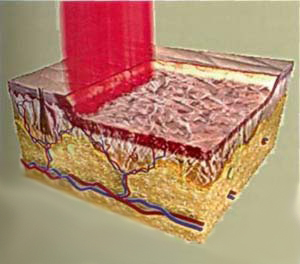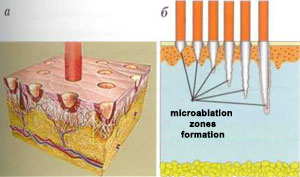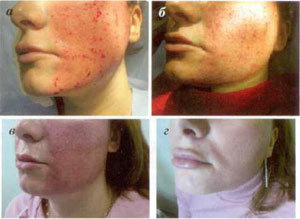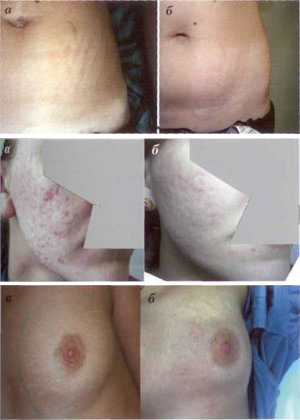Today in the arsenal of modern dermatocosmetology there is a fairly wide range of methods for correcting various aesthetic skin imperfections - chemical peelings, mechanical dermabrasion, laser resurfacing, microdermabrasion, contour plasticsand others. Nevertheless, new directions and technologies in the beauty industry are constantly developing and improving.
This trend is especially typical for hardware methods, primarily for laser medicine. The use of lasers, first in dermatology, and then in cosmetology, has an impressive period. Even since the appearance of one of the newestmethods of laser treatment - selective photothermolysis - have passed more than 25 years. The pioneers of this area, the Americans RR Anderson and JA Parrish, predetermined the fate of fractional lasers in medicine, making them indispensable in the treatment of such aestheticskin imperfections like capillary hemangiomas. Port wine stains, hypertrichosis, tattoos, rosacea, pigmentation disorders, photoaging, wrinkles, etc.
Modern skin remodeling techniques
We live at a time when more people are living to old age than ever before. And given that many of them continue active life, one of the most important problems in aesthetic medicine is the fight against aging skin.
Plastic surgery is able to rejuvenate the shape of the face by removing excess skin. However, at the same time, the skin still remains altered by time (age-related aging) or external factors (photoaging). It is also important that most patients wantlook younger without surgery.
In this case, what method should be used to influence the skin and what should happen in it for its real rejuvenation?
All methods that can be used to improve the appearance of the skin are united by one principle - they use a traumatic effect on the skin, provoking fibrosis, which further leads to its tension and compaction.
Currently, dermatocosmetology uses three main types of remodeling effects on the skin, including:
- chemical stimulation - chemical peels with acids (trichloroacetic, glycolic, etc. );
- mechanical stimulation - mechanical dermabrasion, microdermabrasion, mesotherapy, fillers, subcision with needles;
- thermal stimulation - laser ablation, thermolifting using lasers and broadband light sources, radiofrequency lifting, fractional methods.
Chemical stimulation
Historically, acid exfoliation (peeling) was the first method of skin rejuvenation. The principle of peeling is partial (as with superficial peeling) or almost complete (as with middle and deep peeling) destruction of the epidermis, damagingfibroblasts and dermis structures. This damage activates an inflammatory reaction (the more powerful, the greater the volume of destruction itself), which leads to additional production of collagen in the skin.
However, in order to achieve the desired result, peeling has to sacrifice the epidermis. Experiments with burns have misled many, allegedly "proving" that the epidermis is a self-renewing organ that quickly recovers over the damagedarea. In this regard, peelings until some time became more and more aggressive in relation to the epidermis (for example, deep phenolic peeling), until finally the accumulated problems made specialists realize the viciousness of thisa method that ultimately leads to thinning of the skin.
Proponents of deep peeling ignored the emerging problems. Their essence was that due to the destruction of the papillae of the dermis and the weakening of nutrition, the epidermis becomes thinner, and the number of cells in the prickly layer is significantly reduced in comparisonwith what was before the peeling. A decrease in the barrier function of the stratum corneum leads to a decrease in skin hydration. (Therefore, almost all patients after deep peeling for a long time experience severe dryness of the skin) At the same time, the introduction into practicelighter peels (using trichloroacetic and fruit acids) did not live up to their hopes of effectively tightening the skin.
Mechanical stimulation
Of the methods of mechanical stimulation of involutional changes in the skin, dermabrasion with the use of rotary devices (with a speed of v; rotation of cutters up to 100, 000 rpm) deserves special attention. Currently, modern Schumann-Schreus devices are used(Germany)
The method can only be used in a surgical hospital, since the procedure requires anesthesia, postoperative treatment of the wound surface, a special toilet for the eyes and mouth, as well as devices forfeeding patients (due to the fact that the pronounced postoperative edema that occurs 2-3 days after the procedure makes it difficult to open the eyes and mouth).
The method is very effective, but, unfortunately, with mechanical dermabrasion there is a high risk of complications such as:
- persistent postoperative hyperemia;
- the appearance of areas of depigmentation due to the destruction of melanocytes when the cutter penetrates through the basement membrane;
- wound surface infection;
- scarring (if the cutter is too deeply immersed in the skin)
All of the above has determined the limited application of this method in clinical practice.
Thermal stimulation
Ablative remodeling
Since the late 1980s, a laser has been used to rejuvenate the skin by layer-by-layer tissue removal (ablation) [4]. Careful, low-traumatic removal of the surface layer of the skin using a carbon dioxide laser stimulates the synthesis of its own collagen in it, the amount of which increases several times after the procedure. Then it is gradually reorganized.
The most effective was the use of a CO2 laser, when exposed to a deep thermal effect on all layers of the dermis, externally manifested by the effect of skin tightening. The method is called "laser dermabrasion", or "laserresurfacing ”, and in terms of efficiency it could not be opposed by any other method of skin rejuvenation that existed at that time (Fig. 1).

Fig. 1. Scheme of traditional laser skin resurfacing (laser dermabrasion)
However, the CO2 laser also causes a large number of complications. In addition, further studies have shown that such a deep effect on the dermis stimulates the formation of fibrous tissue to a greater extent than contributes to the synthesis of a new, normaloriented collagen [5]. Developed fibrosis can make the skin look unnaturally pale. Collagen synthesized after treatment is resorbed after a few years, like any collagen formed at the site of the scar. As a result of thinningthe epidermis caused by atrophy of the papillary layer of the dermis, fine wrinkles begin to appear on the skin. Due to the weakening of the barrier function of the stratum corneum, the level of hydration of the skin decreases, and it looks atrophic.
Erbium-aluminum-yttrium garnet-erbium lasers appeared somewhat later. Such advantages of an erbium laser as a shallower thermal penetration depth (erbium lasers penetrate to a depth of 30 microns, CO2 lasers - up to 150 microns)and (as a result) the lower risk of burns and tissue carbonization, as well as the relative cheapness (compared to carbon dioxide lasers), attracted the attention of many specialists around the world.
Nevertheless, as experience of working with these two types of installations is accumulated, the opinion has developed among specialists that CO2 lasers are more efficient [6]. Despite the negative effects of carbon dioxide laser dermabrasion described above, this methodremains indispensable for the correction of acne scars. In addition, it can be considered as an alternative to surgical skin tightening - of all the methods of its remodeling, only exposure to a CO2 laser can actually cause a pronouncedcollagen contraction with visible clinical lifting effect.
The problem with all the methods described above is that they often "sacrifice", that is, significantly damage the epidermis. In order to rejuvenate your skin and really look young, you need a perfect epidermis with naturalpapillae of the dermis, good hydration, normal skin tone and elasticity. The epidermis is a very complex highly specialized organ, up to 200 microns thick, which is our only defense against the effects of negative environmental factors. Therefore, whatever we do to rejuvenate the skin, we need to make sure that its underlying normal architecture is never damaged.
This concept contributed to the emergence of non-ablative skin remodeling technology.
Non-ablative remodeling
The most common devices for non-ablative skin remodeling are neodymium (Nd-YAG) and diode lasers, as well as broadband light sources (IPL). The principle of their action - selective photothermolysis - consists in heating and destruction of structures, containing a sufficient amount of melanin or oxyhemoglobin. In the skin, these are, respectively, accumulations of melanocytes (lentigo, melasma) and microvessels (telangiectasia). The emitted wavelengths used in non-ablative lasers arecorrespond to the maxima of the absorption spectra of oxyhemoglobin or melanin. The procedure for treatment with non-ablative lasers and IPL is quite safe, the rehabilitation period is minimal, however, such treatment eliminates only pigmentary and vascularcosmetic defects. In this case, there is a certain thickening of the skin, but the effect obtained is short-lived.
Fractional Skin Remodeling Techniques
The constant search for new highly effective and at the same time safe methods of skin rejuvenation has led to the emergence of a revolutionary technology - fractional delivery of laser radiation. The proposed skin rejuvenation method has been specially designed to overcomesome of the above difficulties. Unlike "conventional" ablative and non-ablative laser methods, which are designed to achieve uniform thermal damage to the skin at a specific depth, fractional methods allowto achieve its selective microscopic thermal damage in the form of numerous altered columns and leave unaffected areas around these micro-wounds. Currently, the industry produces two types of fractional lasers: non-ablativeand ablative.
The first uses an erbium-doped optical fiber that generates radiation at a wavelength of 1550 nm. The fractional laser forms in the skin thousands and tens of thousands of microdamages in the form of columns - microthermal treatment zones (MLZ) - with a diameter of 70-150mk depth up to 1359 mcm
As a result, about 15-35 skin is photocoagulated on the treated area. The chromophore for the laser is water. Coagulation occurs mainly in the lower layers of the epidermis and dermis. The stratum corneum remains intact because it containsa relatively small amount of water, and this significantly reduces the risk of infection. Epidermal recovery is fast due to the low lesion volume and the short migration distance of keratinocytes. The healing period is accompanied bymoderate edema and hyperemia, followed by desquamation, appearing on the 5-7th day. The patient practically does not lose social activity.
This technology - fractional photothermolysis (FF) - is a highly effective method of non-ablative fractional skin remodeling. To achieve the desired effect, a course treatment is prescribed. Depending on the clinical situation, it is recommendedcarry out from 3 to 6 procedures with an interval of 4-6 weeks. As with any other method of non-ablative skin remodeling, the final result can be seen only 4-8 months after the procedure (cumulative effect).

In cases where a more aggressive effect on the skin is required - for the correction of scars, removal of deep wrinkles and skin excess, the method of fractional ablation (FA, or fractional deep dermal ablation -FDDA) is used.
The fractional ablation method combines the advantages of a CO2 laser and the fractional principle of laser radiation delivery. In contrast to traditional CO2 lasers, which remove the entire skin surface layer by layer, the FA units form a huge number of microablativezones (MAL) up to 300 µm in diameter at a vaporization depth of 350 to 1800 µm (Fig. 2).
Thus, during this procedure, laser radiation, penetrating into the deep layers of the skin, destroys the upper layer of the epidermis. In terms of efficiency, ablative fractional laser rejuvenation can be compared with plastic surgery, this is how deep the laser beam resurfaces.
Fig. 2. The principle of operation of the ablative fractional laser: the formation of microablative zones - MAZ (a); dependence of the MAZ formation depth on the laser radiation power (b)
As in the case of FF, from 15 to 35% of the skin of the treated area is actually exposed (in some cases, up to 70%). Recovery after the FA procedure is faster than after layer-by-layer ablation. This is due to the fact that significantpart of the epidermis and stratum corneum remain intact. Skin bleeding is observed for some time immediately after the procedure, but soon it stops (Fig. 3 a, b).
Fig. 3. Step-by-step skin restoration after the fractional ablation procedure: view immediately after treatment (a); every other day (b); after 5 days (c); 14 days (d) after one procedure

Numerous microbleeds appear in the dermis, which induce a complex cascade of changes leading to the production of new collagen. After the bleeding stops, it is necessary to remove the serous fluid remaining on the skin surface. Its release is observed within 48 hours after the procedure, until complete epithelialization of the microablative zones occurs. During this period, the patient uses special wound-healing external agents. Usually starts from 3-4 dayspeeling and swelling increases (Fig. 3 c). By the 7th day, these phenomena gradually subside, and erythema remains the only noticeable side effect (Fig. 3d). The duration of erythema depends on the parameters of laser exposureand features of skin vascularization. According to the author's observations, erythema lasts no more than 3 months.
The patient's loss of social activity after the FA procedure lasts from 5 to 10 days.
To prevent scarring and the manifestation of post-inflammatory pigmentation, it is necessary to carefully care for the skin. Decorative cosmetics can be used from 4-5 days. A prerequisite for a good result is the use offor at least 3 months after the procedure of sunscreen cosmetics with a high degree of protection (SPF at least 50). The risk of post-inflammatory pigmentation occurs in 20% of patients and is generally higher in patients with skinIV-V phototypes. Such hyperpigmentation is transient in nature and can last from 1 week to 3 months, which also depends on the depth of treatment and the area of the treated area. For its prevention 1-2 weeks before the procedure and duringanother 2 weeks after it, external agents based on hydroquinone (4%) and tretinoin (0. 1%) are prescribed. The main effects on the facial skin after the FA procedure are as follows: pronounced tightening and reduction of excess skin, leveling of the surfacewrinkled skin, as well as skin affected by acne scars, reduction of dyschromia, porosity.
This method was tested by the author and his colleagues also for removing stretch marks of the skin. As shown by clinical studies, the method has demonstrated high efficiency in the elimination of almost all types of stretch marks, both acquired in pubertyperiod and postpartum. It was noted that the healing processes on the skin of the body are different than on the skin of the face.
Mechanism of skin remodeling when using fractional lasers
Let's consider the mechanisms of skin remodeling when using fractional lasers.
After exposure to the laser, aseptic inflammation develops in the area of the formed micro-wounds. The more aggressive the laser exposure, the more pronounced the inflammatory response, which, in fact, stimulates the post-traumatic releasegrowth factors and infiltration of damaged tissues by fibroblasts. The coming reaction is automatically accompanied by a burst of cellular activity, which inevitably leads to the fact that fibroblasts begin to produce more collagen and elastin. The skin remodeling process includes three classic phases of regeneration:
- phase I - alteration (tissue inflammation). Starts immediately after damage;
- phase II - proliferation (tissue formation). Begins 3-5 days after injury and lasts about 8 weeks;
- phase III - tissue remodeling. Lasts from 8 weeks to 12 months.
It should be noted that all three phases of skin remodeling are observed both after fractional photothermolysis and after fractional ablation. But in the first case, the damaging effect of the laser is moderately aggressive, as a result of which a cascade of inflammatorychange is never too wild.
A completely different picture is observed after exposure to the fractional ablation laser. The trauma caused by this laser ruptures blood vessels, and blood cells, along with serum, are released into the surrounding tissue. The full-fledgedmechanism of skin regeneration - pha alteration begins - aseptic inflammation develops. Platelets released from damaged vessels play an important role in activating blood clotting and releasing chemotoxic factors that, in turn, other platelets, leukocytes, and fibroblasts are attracted. Leukocytes, in particular neutrophils, participate in the cleansing of destroyed tissue, removing fragments of necrotic tissue, which are partially destroyed by phagocytitis, and partiallycome out to the surface of the skin in the form of microscopic debris consisting of epidermal and dermal tissue substrates and melanin - microepidermal necrotic debris (MENO).
The proliferative phase begins in about 5 days. During this period, neutrophils are replaced by monocytes. Monocytes, keratinocytes and fibroblasts continue to influence growth factors and at the same time be under their reverse influence. Keratinocytesstimulate the growth of the epidermis and the release of growth factors necessary to stimulate the production of collagen by fibroblasts. In this phase, new blood vessels are formed, and the intercellular matrix is intensively formed.
The last, reconstructive, healing phase after fractional laser exposure lasts several months.
By the 5th day after injury, the fibronectin matrix “fits” along the axis along which the fibroblasts are lined up and along which collagen will be built. An important role in the formation of this matrix is played by transforming growth factor β (TGF-β is a strongchemotoxic agent for fibroblasts), as well as other growth factors. The main form of collagen in the early phase of wound healing is type III collagen (this type of collagen is located in the upper layer of the dermis, just below the basal layer of the epidermis). The longer the alteration phase, the more type III collagen will be produced, but in any case, its amount increases to the maximum from 5 to 7 days after damage. Collagen type III is gradually replaced by collagen over about a yearType I, which strengthens the skin's strength. Blood circulation is gradually normalized, the skin becomes smoother and acquires a natural color.
Comparative analysis of laser methods of skin remodeling
Summarizing the above, here is a diagram showing the relationship between the effectiveness and safety of laser skin remodeling techniques.
Advantages of fractional track rejuvenation methods. The advantages of fractional methods used in clinical practice include:
- controlled minimal skin damage. Histological studies performed after the procedure show an increase in the number of papillae in the dermis, which characterizes the changes in the skin as productive regeneration;
- its effective rejuvenation: the skin becomes thicker, it significantly (more than 400% (! )) increases the production of collagen and elastin;
- short healing time: on average 3 days after FF and 7-14 days after PA;
- minimal risk of hyperpigmentation;
- the possibility of performing the procedure in patients with thin skin;
- the ability to have a healing effect on any part of the body;
- the possibility of using lightweight types of anesthesia: with fractional photothermolysis, only local application anesthesia is used; for fractional ablation, a combination of conduction and infiltration anesthesia is required;
- disappearance of telangiectasias (due to the fact that there is a rupture of blood vessels in so many places that their restoration is impossible).
Main indications for fractional treatments

Indications for fractional photothermolysis:
- increase in skin density in the early stages of aging. The FF procedure is relatively easy and can be administered without fear. The therapeutic effect can be exerted on the neck, décolleté, arms, abdomen, thighs, mammary glands;
- skin photoaging;
- hyperpigmentation, melasma;
- hypertrophic scars;
- stretch marks.
Indications for Fractional Ablation:
- wrinkles of varying severity - from fine lines to strongly pronounced (in the form of furrows);
- age-related loss of skin elasticity and firmness;
- excess skin in the eyelids, neck, face (as an alternative to plastic surgery);
- uneven skin texture;
- pronounced photoaging of the skin;
- acne scars;
- cicatricial deformity of the skin after injuries, operations;
- hyperpigmentation: melasma, lentiginosis, speckled pigmentation, etc.
- vascular dyschromia;
- skin stretch marks;
- actinic keratosis.
In conclusion, a few words about the prospects for the use of laser technologies in aesthetic medicine. We must pay tribute to the manufacturers that they began to pay more attention to the safety of medical procedures using lasers. Technologyconstantly evolved. However, quite often the safety of a method has been sacrificed in order to increase its effectiveness. Or vice versa. A compromise was found in a new principle of delivering laser radiation to tissue. It should be noted that the typeslasers remained the same: erbium, carbon dioxide, neodymium. This suggests that:
- firstly, laser skin remodeling is recognized as the most effective today;
- secondly, the breadth of coverage of aesthetic and dermatological problems solved by these methods is extremely large - from skin rejuvenation to the treatment of congenital and acquired skin pathologies;
- thirdly, with the advent of fractional technologies, the safety and efficacy of treatment have become predictable.













































































